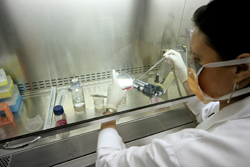What connects sign language and trafficking? Proteins
Abnormalities in the ubiquitin system are implicated in a wide range of pathologies, including certain cancers. Examples are breast and colon cancer, Parkinson's disease, Alzheimer's disease, diabetes and even infectious diseases such as HIV and Ebola. More knowledge about the way proteins signal and how cells decode these signals could unlock the path to new treatments for these major diseases. The EU-funded 'Auto-ubiquitylation project is investigating how decoding mechanisms function at the molecular' (cellular) level. This is important because Ub-receptors are known to decode the signals for thousands of ubiquitylated proteins. A detailed study of how Ub-receptors function reveals much about their role in disease (prevention). Research is being done with biochemical and biophysical assays to investigate whether open and closed structures are involved in the function of Ub-receptors. What the project proposes is that Ub-receptors can 'acquire' three structural states: 'apo', which is the unbound form, 'trans' which is bound to another ubiquitylated-protein, and 'cis' which is self-ubiquitylated. Determining a cis structure has been crucial for understanding how molecules interact among themselves to regulate protein function (auto-inhibition). So the project developed a novel bacterial system for protein ubiquitylation that will help determine high-resolution structures of Ub-receptors in cis form and give better understanding of how auto-regulation takes place. Project partners expect that their work will make it possible to pharmacologically manipulate the Ub system. Results in this area will serve as templates for the future design of new drugs for diseases such as AIDS and cancer.







